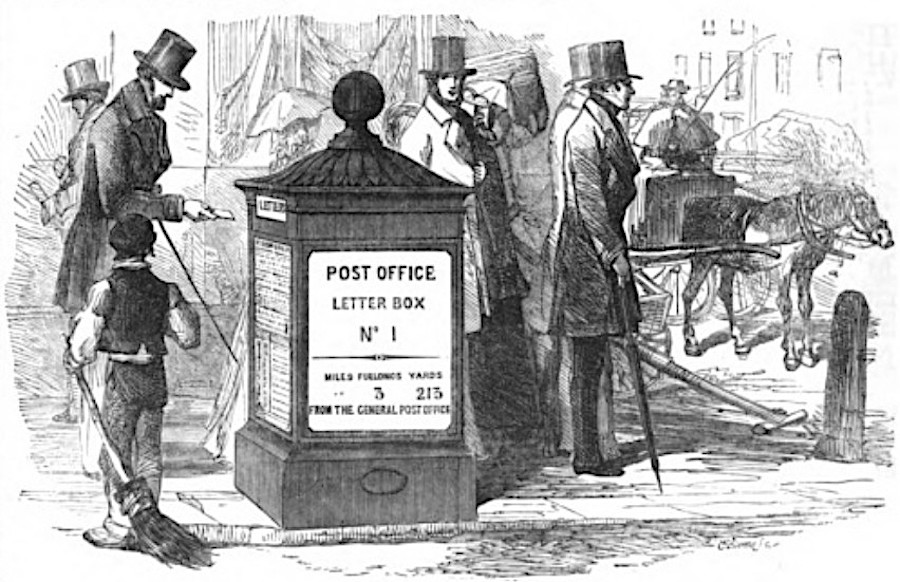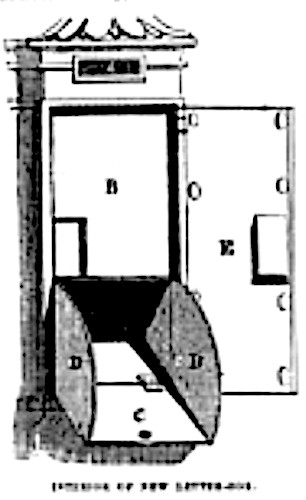
The New Post-Office Letter-Box, at the Corner of Fleet-Street and Farringdon-Street. The article runs as follows:
The accommodation of the Post Receiving Houses in various parts of the metropolis has long been of a very imperfect kind. Formerly a Receiving House was denoted by richly-emblazoned pane, in which the time-honoured British lion shone in full national emblazonry; and here and there the tutelar animal's mouth was the receptacle of letters; just as the just as the famous Lion's head at Button's coffee-house, received contributions for the Guardian. Few shop-fronts, however, bore so distinctive a feature; but the letter-mouth might be seen at various levels — rarely, as an artist would say, "on the line" — so as to render its discovery somewhat perplexing when the mixed topography of shop-windows is considered. Then came the mean-looking iron crown upon the top of the nearest street-lamp, which did not much enlighten the public in their pursuit of a post-ofiice under difficulties. Next, the example was set by the French Post-office authorities of having cast-iron pillars set up in various streets of Paris, for the reception of letters; and this experiment having been found successful, a similar plan has been adopted by the authorities in St. Martin's-le-Grand. At stated points have been erected cast-iron letter-boxes, one of which — that at the corner of Fleet-street and Farringdon street — is shown in the accompanying Illustration. It is much less ornamental than the Paris pillar. Our Letter-box is a stove-like design, reminding one of the latest of the London conduits. An outer panel of box bears this inscription:-
Newspapers posted here will not be forwarded.
Letters containing Money or Valuable Articles should be registered at a Post-office.
THE NEAREST POST-OFFICE IS AT 101 FLEET-STREET.
For the Morning Mails, are collected here, 5 a.m.; for the Evening Halls, 5.30 p.m.
Letters bearing an Additional Penny Stamp may be Posted for the Evening Mails, 6 p.m.
[A chart of collection and delivery times follows, after which comes a description of the box itself:]

The material is cast iron; and the manufacturers are Messrs. H. and M. D. Grissell, of the Regent's Canal Ironworks, Eagle Wharf-road, New North-road, Hoxton. The front of the Letter-box is shown in the Engraving; and the accompanying Diagram shows the interior contrivance for taking out the letters: — A, opening for letters; B, inner wooden front of box; C, flap, which opens and forms an inclined plane with the bottom of the box, by which means the letters are shot into the postman's bag; D D, slides to the flap, to prevent the letters falling over; E, inside of iron door. The locks are the "patent detector," by Messrs. Chubb, St. Paul's Churchyard (280).
Images downloaded and text transcribed by Jacqueline Banerjee. You may use these images without prior permission for any scholarly or educational purpose as long as you (1) credit the person who scanned them, the Hathi Trust and Princeton University and (2) link your document to this URL in a web document or cite the Victorian Web in a print document. [Click on the images to enlarge them.]
Bibliography
"New Street Letter-Boxes." Illustrated London News. 24 March 1855. Hathi Trust, from an original volume in the Princeton University Library. Web. 20 May 2019.
Created 20 May 2019